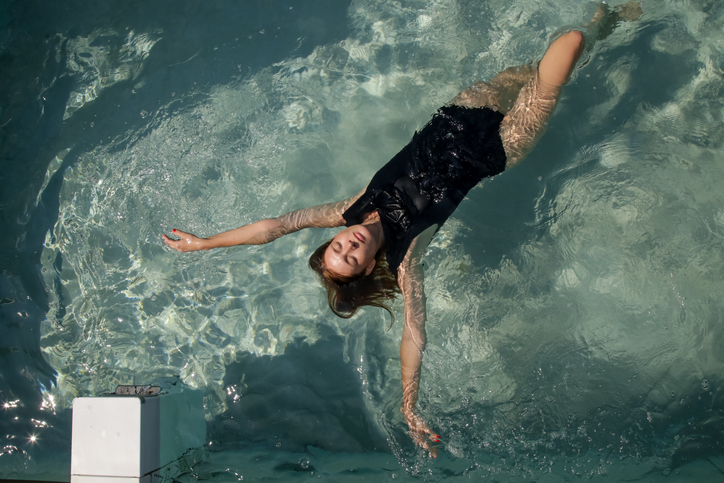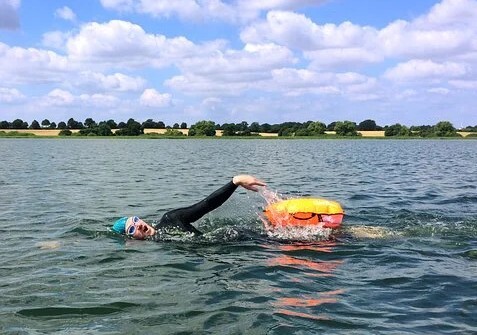Swimming in nature is exhilarating. There is a kind of joyous freedom in being just one lone human seemingly out in the world alone. But with that freedom comes a self-responsibility that can be crucial for your survival.
Like all sports and adventures, swimming in open water has its own special set of safety guidelines. Being as we were not born with gills, our first mission in the water is to make sure we continue to be able to breathe.
You have watched people riding on inner tubes, trailing their beer coolers, laughing and splashing down the river and possibly thought how fun that would be. Fun and safety should be tube mates but in a split second they can part ways.
Perhaps you have wished to be playing in the surf like that guy who just body surfed a six-foot wave for 50 yards. It looks so easy, just go throw your arm out and ride that wave right on into the beach, right? Uh, no. Not right at all.
One of things that you don’t see when you watch people doing things well, or doing something that appears so simple and easy, is the learning and practicing of ‘safety consciousness’ required to reach a seemingly carefree state at play. Nothing is fun when you are in danger. Nothing is easy when you don’t know how to do it. Being safe in wild water is a game you can win if you learn the rules.
Rule number one – If you don’t know, don’t go.
Safety starts with a good decision. You may have people on shore, but you would rather not have them watch you struggle or need them to do something to save you that they may not be prepared to do. Make sure that anyone with you remaining on the shore has a plan in the event you need help. You cannot expect someone who can’t swim or is afraid of the water to save you.
Rule number two – Take the time to watch first.
Get familiar with the surroundings. It is important that you know just what you are getting into. Take fifteen minutes to observe the patterns of movement and wind on the water you are considering. Look at the weather, the sun, feel the wind. Find the direction of the wind, the height and direction of the sun, and study the water for patterns on the surface. All this will help you determine if there are currents, so note the patterns. All this will become important if you find yourself in trouble.
Rule number three – Check out the conditions.
Test the water for temperature. Go in up to your neck. If you get cold, don’t swim so far. Wade in, discover what the terrain is underneath the water. Rocks, muck, sand, slippery slime, all the above, you need to know your footing if you have to get out fast. Acclimate yourself to the environment. In a river, water will be colder to you because of its movement. Note your surroundings so you will be able to navigate your way back upstream if you get carried away. On a lake or the ocean, watch the shore for landmarks and keep your eye on the shore to keep your bearings. Sometimes you are unaware of current until you’ve drifted into danger.
Rule number four – You are your own lifeboat.
Know your own abilities and your limitations. If you aren’t a good swimmer, respect that. Make sure you have the tools and mental strength for your mission and prepare yourself to succeed. Always remember that any distance you swim out, you must swim back. Pace yourself and don’t let yourself go beyond your abilities.
A good test is to swim back and forth in a pool till you get tired. Count your strokes, time yourself, sing a song you know while you swim. Then stop, look at the clock or start the song again or start counting again and swim till you cannot swim any more. Check your time. This information will become your gauge of what you can do. Remember this when you head for open water; you need to make it back to shore.
Rule number five – Remember that you float and keep your head back.
Increase your capacity and confidence. Remember if you swim out until you are tired you may not have what it takes to make it back in. Learning to float literally can save your life.
Before you attempt open water, practice the emergency float until you are comfortable and can say, ‘I could do this for hours.’ (Back in the day we called it ‘the dead man’s float’ because if you couldn’t hold it up, well, you get the idea.)
Lay on the water spread eagle, face up, with your ears submerged looking back up over your head. Even when your arms and legs begin to sink, your face will remain clear. Be conscious of your breathing, relax. Slowly move your arms in big sweeps, and big slow leg kicks, to keep as much of your body on the surface as you can. Fear is heavy, panic is heavy, calm is light as a feather.

With your chin being the highest point, you should be able to float, calmly and relaxed, for hours. It takes practice but is well worth the effort and can save your life. At any time when you are swimming, in any body of water, if you get tired, flip over and float. Float until your breathing slows and your mind calms down before resuming swimming.
The most important thing you can do to keep safe is to keep calm. No matter how rough or deep the water gets, you can float in it. Even good swimmers can get into trouble if they panic. If you are swimming alone, you are the only one who can save you, so don’t try more than you know you can do.
Lastly, remember that water is your second natural environment. Many creatures live in it full time. Wherever you swim, remember you are a guest. Have great fun and swim with respect for those who dwell there.
Need more assistance preparing for an open water swim? Hire a private swimming instructor to take your swimming skills to the next level!
Shawn King’s bio:
Swim Instructor in Farmers Branch, TX
Hi, I'm Shawn and I've been teaching swimming for 40 years. I feel that swimming is on the Top 10 list of things to know how do in life. I work with all ages from toddler to adult because I love sharing my passion with anyone who wants to learn to swim. I was a lifeguard as a teenager and coached kids just getting into the sport. I love swimming, and I love teaching so it's a lifelong match for me. I also teach cooking, sewing, and gardening lessons to both kids and adults.
ABOUT SUNSATIONAL SWIM SCHOOL
Sunsational Swim School is the 🥇 #1 rated provider of private, at-home swimming lessons in America. We have specialized swim instructors for students ages 6 months to adult, beginner to advanced. Featured on ABC, CBS, Impact 100, The List and others, Sunsational instructors have a minimum of 2 years of teaching experience, are CPR certified and insured, and have collectively taught over 302,223 lessons for more than 74,415 students nationwide!




